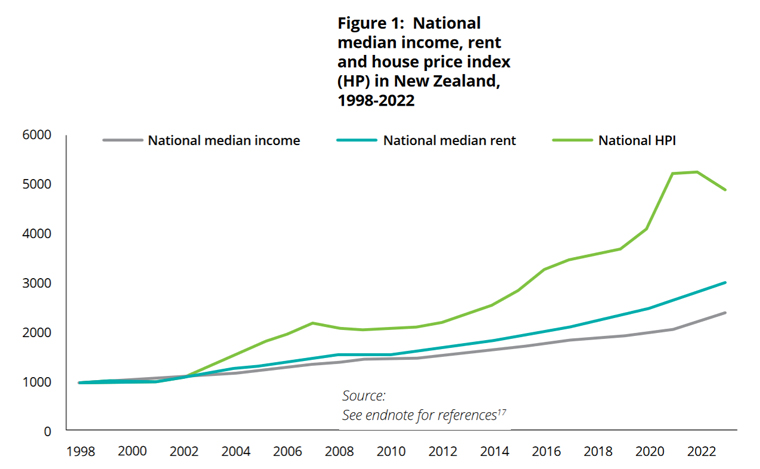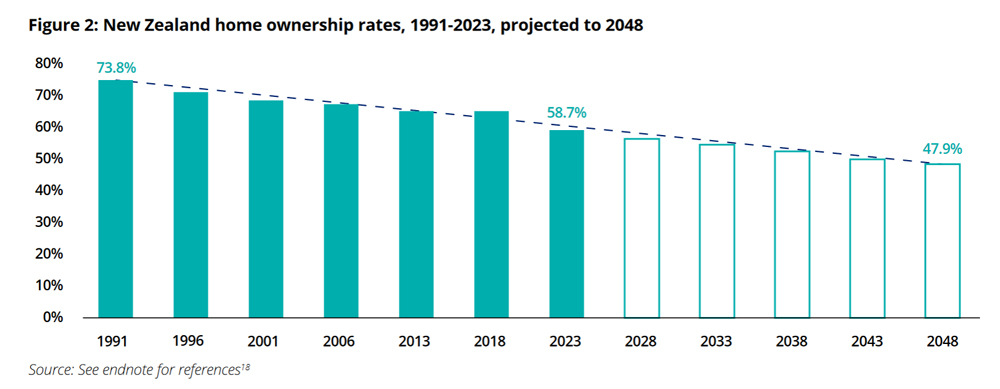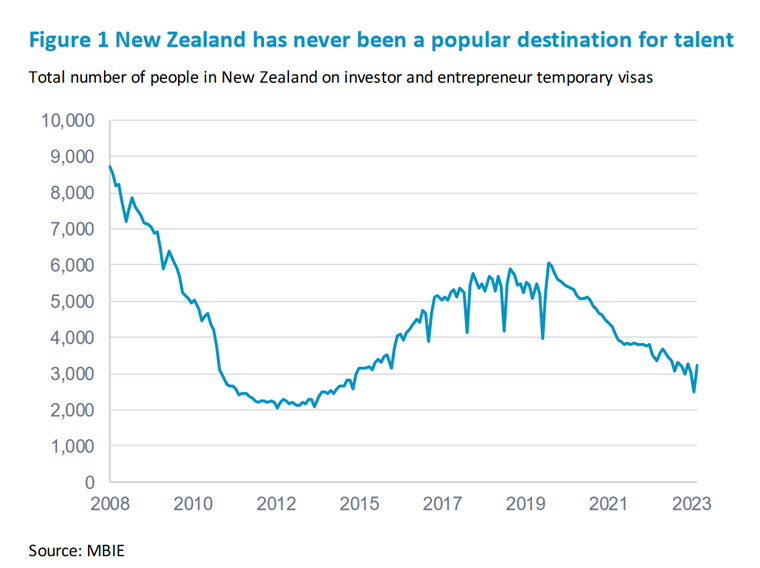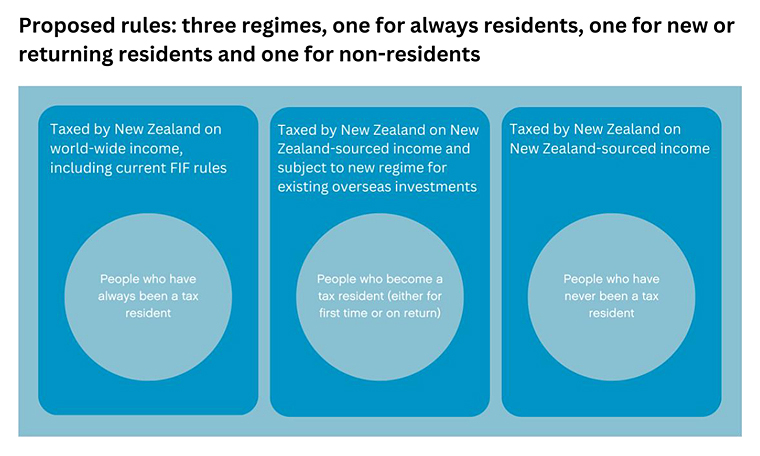
Last week, as part of its continuing drive to increase compliance, Inland Revenue released an updated property tax decision tool.
What this does is help people work out when a property might be taxable under any of the land taxing rules, including the bright-line test. It's been updated to take account of the bright-line test changes which took effect on 1st July this year.
The growing issue of helping families into housing – what are the tax implications?
Generally speaking, since 1st July, the bright-line test only applies where the end date for sale as determined under the rules is within two years of when the property was deemed to have been acquired. The aim of the tool is to work through all the various scenarios that might apply. So that's something worthwhile, and I think we're going to see more of people wanting to make more use of this because of a developing trend around shared home ownership where people who are not necessarily couples are coming together to purchase properties. There are also families wanting to help elderly parents.
We’re seeing some very interesting scenarios develop as a result. One of those scenarios was the subject of last week's Mary Holm’s column for the New Zealand Herald.
“We’ve bought my wife’s parents’ house. They had a small mortgage on it, with no income, just super, coming in. They didn’t have enough money to keep paying the mortgage, hence they were going to start a reverse mortgage to keep things afloat.
If they sold the house they would’ve struggled to get into a retirement village and stay near family etc. So we bought the house so they don’t ever have to leave - so let’s say they will be there for at least another 10 years.
They pay us $750 rent per week. We took out a 30-year $800,000 mortgage, with just the interest on it at $1977 a fortnight, so we are topping up mortgage payments as the rent does not cover it. We also pay the rates, insurance and any maintenance costs.
How do we treat this in terms of any possible tax or claims as such?”
Mary asked Inland Revenue and me for comment. Notwithstanding that a net loss was foreseeable, my advice was you never always know what the full story is as there may be a detail which for whatever reason, the correspondent has overlooked. The basic approach I took was you should report it. Inland Revenue were much of the same view but noted that any excess deductions would be ring fenced.
As I mentioned to Mary, I think we're going to see a lot more of this. Because they're coming from both ends of the generational spectrum. In this case we've got the elderly parents wanting to stay near family and then at the other end, young people trying to get on the housing ladder.
Is shared home ownership an answer to housing affordability?
Over the last 20 years or so I've seen the practice develop quite rapidly of parents, grandparents and other relatives helping their children or grandchildren get their foot on the property ladder.
An interesting report on shared home ownership, looking at shared equity and leasehold schemes, released by Westpac notes the housing market is increasingly difficult, and “the home ownership dream is increasingly out of reach for some New Zealanders”. The report’s analysis is that shared home ownership will become increasingly common, and looks at how that might develop.
The report describes the housing market as “distorted” and to give you some idea of the scale of the problem, the report notes “As of February 2024, the median house price was 6.8 times the median income compared to 5.4 times in 2004 and roughly 2.3 times in 1984.” So over 40 years, the median house price relative to median income has practically trebled.

The report also notes that home ownership rates in New Zealand have been declining steadily since peaking in 1991 at 73.8%. They're down to 58.7%, so a 15 percentage point drop over 30 years is pretty substantial. But the report projects that within 25 years, the proportion of homeowners will have dropped to 47.9%. (The report notes the outlook is even worse for Māori and Pacific peoples, where the home ownership rate is lower, at 47% and 35%, respectively, as of 2023).

What are we going to do about this? Well, as the report suggests shared home ownership is going to become more common. This in turn is going to trigger all sorts of tax issues. Which is why something like Inland Revenue’s property tax tool is handy. The report, incidentally, doesn’t really discuss tax other than mentioning tax free capital gains do play a part in people's investment decisions and may have an impact on the housing market
There's no real short answer to this issue. Raising incomes would be one thing, freezing or slowing the rate of house prices would be another, and building more homes would be a vital third factor. Pulling all this together is a huge problem and each solution comes with secondary effects.
International tax deal in trouble?
Moving on an equally complicated scenario and one we've been covering for several years , is the question of the taxation of multinationals. Back in 2021, the OCED/G20 declared a breakthrough international tax deal over the taxation of the largest multinationals in in the world. The deal proposed a Two-Pillar solution over the question of taxing rights. Ultimately this is where the idea of a minimum corporate tax rate of 15% emerged.
Agreeing in principle was one thing, but the negotiations have been going on since then and increasingly it seems to be that they're running into difficulty. A key 30th June deadline has now passed, and it appears that some governments are starting to lose patience with the whole process.
One of the ideas behind the agreement was to head off the implementation of digital services taxes (DSTs). As part of the process these DSTs were put on hold by several jurisdictions, including the UK, Austria, India and others. In the meantime, as negotiators have dragged on other countries such as Canada have said “Well, we've had enough of this, we're going to go ahead and impose a digital services tax.”
Meantime, the United States whose companies such as Alphabet and Meta are at the heart of the issue have threatened retaliatory tariffs on countries imposing DSTs. Nobody wants a trade war, but someone has to blink in terms of getting a deal past this impasse. So, they're continuing to negotiate, even though the deadline theoretically has expired.
Time to go back to first principles?
On the other hand, as Will Morris, PWC’s Global Tax Leader points out in this short video. Maybe we should just go back to first principles instead of trying to hammer out a deal through the existing Pillar 1 process which some consider is not really fit for purpose.
It's not a bad idea but it would delay further progress in the matter, and I think that's where governments who've got elections to win may not be prepared to wait much longer. I think generally the public is a bit antsy about the question of corporate taxation. As I noted last week, when we looked at the OECD's latest corporate tax statistics, statutory corporation tax rates have pretty much stabilised after 20 years of falling.
However, there are still substantial gaps in public finances as a result of first the Global Financial Crisis, then the pandemic and increasingly we're having to deal with the impact of climate change as well. When the insurers are leaving the market, who picks up the tab? In my view, that's going to be we the taxpayers.
There will be pressure to get some sort of deal across the line, but I also think although we may see corporate tax rates elsewhere in the world rise, I think with our 28% rate, we haven't really got much room for manoeuvre for an increase at this point.
A place where talent does not want to live?
Finally, the New Zealand Institute of Economic Research released a fascinating report on Thursday. Provocatively titled The place where talent does not want to live, it looks at the question of New Zealand's immigration policy and how that sits alongside our international tax regime.
The report was prepared for the American Chamber of Commerce in New Zealand, the Auckland Business Chamber, the Edmund Hillary Fellowship and the NZUS Council. It's a fascinating document because it pulls together points, we don't always hear discussed when we're looking at immigration policy, how does our tax system interact with that policy?
The report notes that conceptually, we have developed tax rules which make sense in a tax context. However, they lead to wider issues once they start operating in a broader context. In particular the report really focuses on the Foreign Investment Fund (FIF) regime which it considers disadvantages many investors who come here hoping to use their skills and their capital to help build the economy and the tech sector in particular.
I've seen comments on this topic previously from entrepreneurs, and it’s easy perhaps to be cynical and say, “Well, they’re speaking out of self-interest” but 40 years of tax experience also tells me that behavioural responses to tax are very observable and policymakers should pay attention to such responses.
An in-depth examination of the Foreign Investment Fund regime
What makes this report particularly interesting are the authors, Julie Fry and Peter Wilson. Julie is a dual New Zealand and U.S. citizen who in her bio notes that “her location and financial decisions have been impacted by the tax rules covered in the report.” Peter was Manager of International Tax at the New Zealand Treasury from 1990 to 1997 and then Director of Tax Policy from 1998 to 2002. As such “He was responsible for advising the government on many of the tax issues contained in this report.” Consequently, outside of anything prepared for a tax working group, this report is one of the most in-depth examinations we've seen of our international tax regime and FIF regime.
The report notes that although we have a fairly open flow of migrants, “New Zealand has never been a particularly popular destination for talented people”. (Interestingly, we have no data on how long people on the various investor and entrepreneur visas stay).

As the report notes there's a competition for global talent and New Zealand is not attracting as many as we would like. We should therefore be thinking hard about the implications of this.
The report hones in on the FIF regime as being a particular problem for many investors because of the way that it taxes unrealised gains. This creates a problem of a funding gap where an investor is expected to pay tax on an investment which very often isn't producing cash because as a growth company cash is being reinvested. (By the way, this is often a common argument against wealth taxes).
As the report notes, “New Zealand's tax rules were not designed with the idea of welcoming globally mobile talent in mind.” For example, as Inland Revenue’s interpretation statement on residency makes clear it’s deliberate policy to make it's easy to be deemed tax residency in New Zealand, and hard to lose. This has long term flow implications because as the report points out, people who would perhaps want to commit to New Zealand are reluctant to do so because of the tax consequences of doing so.
Chapter 3 is the very, very interesting section of the report as it explains the development of our current international tax regime and the rationale for the various FIF regimes and their design. The overall objective was to protect the tax base, but they didn't really think about what was happening with migrants. As Ruth Richardson and Wyatt Creech then the respective Minister of Finance and Minister of Revenue explained in 1991
“The objective of the FIF regime, where it applies, is to levy the same tax on the income earned by the FIF on behalf of the resident as would be levied if the fund were a New Zealand company. Because the FIF is resident offshore with no effective connection with New Zealand, the only way of levying the tax is on the New Zealand holder.”
This is conceptually correct from a tax perspective but as the report keeps pointing out, it doesn't really take into account what happens with migrants who made investment decisions long before they arrived in New Zealand only to find their accumulated savings are being taxed here under the FIF regime. I have a similar problem with the taxation of foreign superannuation schemes. Although the tax treatment conceptually ties in with our system, it seems to me we are effectively taxing the importation of capital and this paper is basically saying the same thing in relation to FIF.
How much tax does the FIF regime raise?
Section 3.5.1 on page 26 of the report has an interesting analysis of how much revenue the FIF regime raises. Because our tax reporting statistics aren't very detailed, the answer is we don't really know. The report concludes
“The high-level finding is that the level of overseas investment is small compared to total financial assets at the national level. Portfolio foreign investment is, in some years, one-thousandth of domestic investments. This suggests that the current FIF tax base is likely only to make a minor contribution to direct revenue.”
A suggested reform
The report concludes that in an international context where we were trying to attract the right talent, maybe we should be looking at the FIF regime. What it suggests as is to separate the tax treatment of people who have always been tax resident from those of new and returning tax residents. The existing FIF rules would continue to be applied to those have always been New Zealand tax resident. Meantime a new regime should be designed for new and returning tax residents.

The report does touch on the question of a general capital gains tax regime (which could be an answer) but considers the development of a comprehensive CGT is a long term political consensus building project.
In discussions I've had with other colleagues on this matter we’ve noted how our American clients in particular are very affected by the current FIF regime. As American citizens they are required to continue to file American tax returns and are therefore subject to capital gains tax. This creates a mismatch between when they pay New Zealand income tax and the final US tax liability on realisation. Although the FIF regime creates foreign tax credits for US tax purposes clients are frequently not able to utilise the foreign tax credits.
As people told the report authors this is extremely frustrating and there is no doubt that people are upping sticks and moving because of it. (I’ve also seen other clients switch into property investment instead).
Overall, this is a very interesting and highly recommended report considering the intersection of tax driven behaviour with wider economic issues.
And on that note, that's all for this week, I’m Terry Baucher and you can find this podcast on my website www.baucher.tax or wherever you get your podcasts. Thank you for listening and please send me your feedback and tell your friends and clients. Until next time, kia pai to rā. Have a great day.
5 Comments
'As the report notes there's a competition for global talent and New Zealand is attracting as many as we would like. We should therefore be thinking hard about the implications of this.'
Perhaps this ought to read
'As the report notes there's a competition for global talent and New Zealand is NOT attracting as many as we would like. We should therefore be thinking hard about the implications of this.'
Hi John now revised, thank you.
Westpacs report needs it's title reviewing as well.
Should read as the next step backwards.
Those housing stats are damning.
The graph showing decline in investor / entrepreneur visa - what relevence is that to talent?
Those homeownership rates are pretty depressing. When I was but a wee lass back in high school, I remember most of my teachers owned their own homes. They also went on overseas holidays, and other such luxuries. It's hard to think back on those times, and not get a sense that it's become altogether harder to do what used to be normal. Does anyone know if there is data on how many homes are owned by investors? Like, are we seeing a concentration of houses in fewer and fewer hands? Also, as for immigration - does INZ publish the top 10 occupations arriving on temporary working visas? This seems like pretty basic data, but I have no idea where to find it. If you have any idea, please let me know.

We welcome your comments below. If you are not already registered, please register to comment
Remember we welcome robust, respectful and insightful debate. We don't welcome abusive or defamatory comments and will de-register those repeatedly making such comments. Our current comment policy is here.